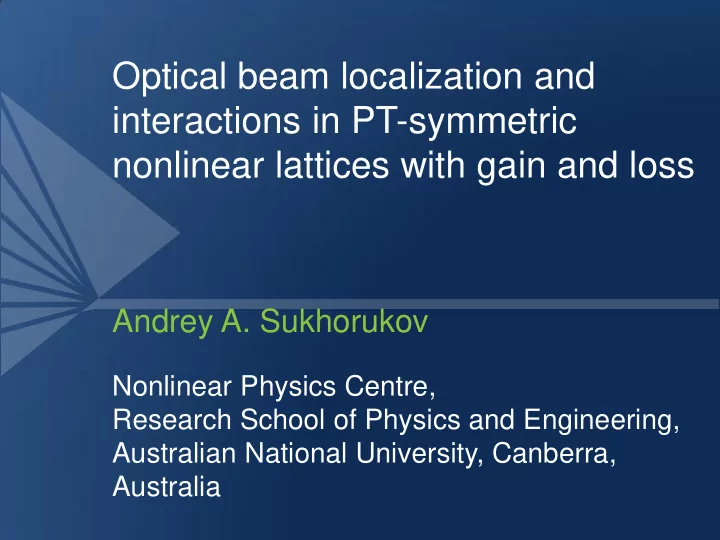

Optical beam localization and interactions in PT-symmetric nonlinear lattices with gain and loss Andrey A. Sukhorukov Nonlinear Physics Centre, Research School of Physics and Engineering, Australian National University, Canberra, Australia
Team and collaborators Andrey Sukhorukov, Zhiyong Xu, Yuri S. Kivshar Nonlinear Physics Centre, Australian National University, Canberra, Australia Sergey Dmitriev, Sergey Suchkov Institute for Metals Superplasticity Problems, Russia
Outline Concept of parity-time (PT)-symmetry and recent progress in optics Gain Loss Nonlocal effects: PT-symmetry breaking sensitive to distant structure boundaries Hermitian PT Scattering of solitons on PT-symmetric couplers
PT symmetry in optics Gain Loss • Coupled waveguides • Parity-Time symmetry: identical waveguides, equal magnitudes of gain and loss El-Ganainy et al., Opt. Lett. 32, 2632 (2007); Guo et al., Phys. Rev. Lett. 103, 093902 (2009); … • Observed experimentally Ruter et al., Nature Physics 6, 192 (2010).
Coupled waveguides with gain and loss • Parity-Time symmetry: Gain identical waveguides, equal Loss magnitudes of gain and loss • El-Ganainy et al., Opt. Lett. 32, 2632 (2007); Guo et al., Phys. Rev. Lett. 103, 093902 (2009); Ruter et al., Nature Physics 6, 192 (2010). • PT symmetry: supermodes do not experience gain or loss; zero gain/loss on average for arbitrary inputs • Broken PT symmetry (increased gain and loss): mode confinement and amplification in the waveguide with gain Ruter et al., Nature Physics 6 , 192 (2010).
Nonlocal effects • PT-defect – non-Hermitian • Quantum-mechanical context: interaction of a non-Hermitian system with the Hermitian world Hermitian PT • Dynamics can be sensitive to potential at distant locations • Continuing debate on the meaning of nonlocality and relevance to real physical systems H. F. Jones, Phys. Rev. D 76, 125003 (2007); M. Znojil, Phys. Rev. D 80, 045009 (2009 ); …
PT nonlocality in optical systems? Our approach to study nonlocal effects • Consider pair of waveguides with balanced gain and loss in a chain of waveguides • Realizes PT defect embedded in a conservative lattice • Compare different topologies: planar and circular • Study the degree of nonlocality due to distant boundaries Sukhorukov, Dmitriev, Suchkov, Kivshar, Opt. Lett. 37 37, 2148 (2012)
Mathematical model • a j – mode amplitudes at waveguides • C – coupling coefficient between the waveguide modes • – coefficient of gain/loss in waveguides 0,1
PT symmetry breaking for isolated coupler • Stability condition Gain • Predicted and observed previously Loss • PT symmetry: supermodes do not experience gain or loss; zero gain/loss on average for arbitrary inputs • Broken PT symmetry (increased gain and loss): mode confinement and amplification in the waveguide with gain Ruter et al., Nature Physics 6 , 192 (2010).
PT symmetry breaking for planar lattice • Boundary conditions • Consider eigenmodes: • PT symmetry: • For • For • Consider • Solvability of last relation defines PT symmetry
PT symmetry breaking for planar lattice • Stability condition • Same stability condition as for isolated PT coupler! • Does not depend on lattice coupling outside the active region
PT symmetry breaking for circular lattice • Boundary condition: • Waves can circulate around, passing through active waveguides • Eigenmode as sum of counter-propagating waves • ‘+’ – n 1; ‘ - ’ – n 0 • Wave scattering at PT defect: • Transmission coefficient • Reflection coefficient • Boundary condition:
PT symmetry breaking for circular lattice • Consider ratio • PT symmetry breaking occurs at a given k when solutions disappear • Threshold corresponds to real k • Stability condition: • Threshold depends on all lattice parameters
Combined stability diagram • Different stability domains in regions 1 and 2 for arbitrary large lattice lengths • Nonlocality irrespective of the lattice size! Stability regions 1,2 Stability regions 1,3
Instability in infinite lattices • Construct modes localized at PT defect • Exponential localization: • For • Which requires • Modes cease to exist – PT symmetry breaking
Instability in infinite lattices • Common instability threshold for infinitely long planar or circular lattices • Stability condition:
Instability growth rate • Top - N=20 sites • Bottom N=100 sites • Dashed line – infinite lattice threshold • Above dashed line – almost no depednence on lattice size • Solid line – finite lattice threshold • Between solid and dashed lines – instability reduces as 1/N
Instability sensitive to boundaries • Consider N=50 sites – solid lines /C 2 = 0.8 • Instability for planar structure only through reflections from boundaries
Instability independent on boundaries • Consider N=50 sites – solid lines /C 2 = 2 • Instability develops around PT defect, no effect of boundaries
PT coupler in a nonlinear chain • Distant boundaries (infinite lattice limit) • Kerr-type nonlinearity • Conservative solitons exist on either sides of PT coupler
Soliton scattering by PT coupler • Lattice parameters • Soliton velocity • Localized mode at PT coupler is excited when soliton amplitude is increased (right)
Soliton scattering by PT coupler Soliton scattering • Black circles – transmission, open circles – reflection of solitons • Lines – linear regime PT mode excitation • Power of the localized mode at PT coupler, after the soliton transmission
Controlling soliton scattering with localized PT modes Soliton scattering - soliton phase • • Labels – localized PT mode amplitude PT symmetry breaking • Mode amplitude 1.4 Left: =3.67 • PT symmetry preserved Right: =3.75 • nonlinear PT symmetry breaking
Conclusions PT-symmetric structures: waveguides Gain with balanced gain and loss Loss Nonlocal effects: different stability for planar and circular structures with gradual transition to a common threshold for infinite lattices Soliton gain/loss due to scattering on PT defect, controlled by PT defect mode Dmitriev, Suchkov, Sukhorukov, Kivshar, Phys. Rev. A 82 82, 013833 (2011) Sukhorukov, Dmitriev, Suchkov, Kivshar, Opt. Lett. 37 37, 2148 (2012)
Recommend
More recommend